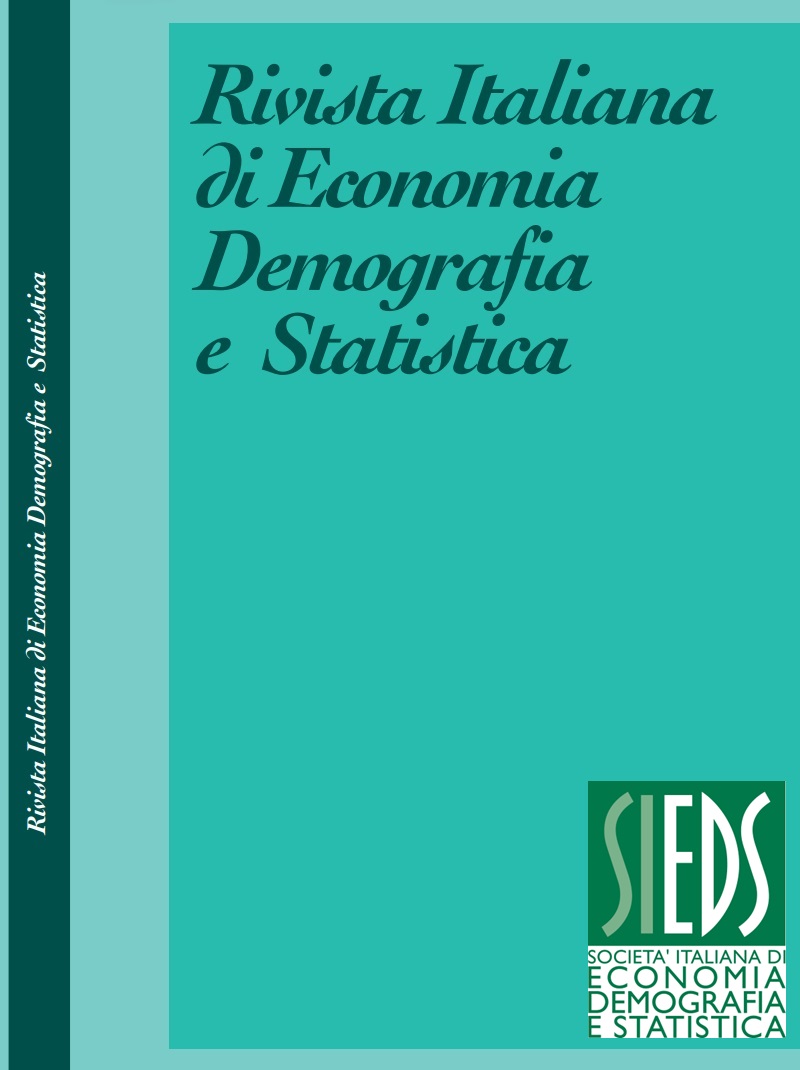Residential segregation in Messina (Southern Italy): an information theory based study
DOI:
https://doi.org/10.71014/sieds.v79i3.307Abstract
Residential segregation stands out as one of the most noticeable and potentially concerning consequences of urbanization. Adopting the framework proposed by the Information Theory, the study investigates residential segregation patterns in the Italian municipality of Messina that has recently experienced deteriorating urban conditions. We rely on anonymized individual data sourced from the Population Register to examine the major immigrant groups residing in Messina in 2016 and 2022, Sri Lankans, Filipinos, Romanians, and Moroccans. The analysis computes the Shannon’s entropy index and Kullback-Leibler (KL) divergence, aiming at: 1. drawing comparisons in the residential segregation patterns among immigrant populations; 2. appraising changes in residential patterns between 2016 and 2022; 3. assessing to what extent ethnic concentration depends on the adoption of different territorial scales to classify metropolitan areas. Results reveal nuanced patterns of residential segregation among the selected migrant populations, with Filipinos and Moroccans remaining the most segregated groups, both in 2016 and 2022. However, two common dynamics are affecting all immigrant groups: a. the presence of micro-scale segregation; b. the increase of segregation degrees over time. Furthermore, when comparing the distribution of immigrant groups with native populations, concentration levels, detected by the Shannon’s entropy index, have not always implied significant KL divergence. These results suggest complex interactions between migrant and the local populations, challenging simplistic assumptions about segregation. Accounting for the multi-scalar dimensionality of segregation, this study contributes to a deeper understanding of residential dynamics and provides insights for fostering social cohesion in diverse spatial urban settings.
References
ARCAYA M.C., SCHWARTZ G., SUBRAMANIAN S. 2018. A multi-level modeling approach to understanding residential segregation in the United States. Environment and Planning B: Urban Analytics and City Science, Vol. 45, No. 6, pp. 1090–1105. DOI: https://doi.org/10.1177/2399808318760858
BITONTI F., MAZZA A., MUCCIARDI M., SCROFANI L. 2023. Urban transformations and the spatial distribution of foreign immigrants in Messina. Models for Data Analysis. Selected papers of 49th Meeting of Italian Statistical Society, pp.53-67. DOI: https://doi.org/10.1007/978-3-031-15885-8_5
COULTER P.B. 1989. Measuring Inequality: A Methodological Handbook. Boulder: Westview Press.
COVER T.M., THOMAS J.A. 2006. Elements of Information Theory. Hoboken, N.J.: Wiley-Interscience.
JONES K., JOHNSTON R., MANLEY D., DEWI O., CHARLTON C. 2015. Ethnic Residential Segregation: A Multilevel, Multigroup, Multiscale Approach Exemplified by London in 2011. Demography, Vol. 52, pp. 1995–2019. DOI: https://doi.org/10.1007/s13524-015-0430-1
KAHLE D., WICKHAM H. 2013. ggmap: Spatial Visualization with ggplot2. The R Journal, 5(1), 144–161. DOI: https://doi.org/10.32614/RJ-2013-014
KULLBACK S. 1987. Letters to the Editor. The American Statistician, Vol. 41, pp. 338–341. DOI: https://doi.org/10.1080/00031305.1987.10475510
LECKIE G., PILLINGER R., JONES K., GOLDSTEIN H. 2012. Multilevel modeling of social segregation. Journal of Educational and Behavioral Statistics, Vol. 37, No. 1, pp. 3–30. DOI: https://doi.org/10.3102/1076998610394367
LOUF R. 2016. Patterns of residential segregation. PLoS ONE, No. e0157476. DOI: https://doi.org/10.1371/journal.pone.0157476
MASSEY D.S., DENTON N.A. 1988. The dimensions of residential segregation. Social Forces, Vol. 67, pp. 281–315. DOI: https://doi.org/10.2307/2579183
ÖSTH J., CLARK W.A.V. MALMBERG B. 2015. Measuring the scale of segregation using k-nearest neighbor aggregates. Geographical Analysis,Vol. 47, No. 1, pp. 34–49. DOI: https://doi.org/10.1111/gean.12053
R CORE TEAM. 2023. R: A language and environment for statistical computing. Vienna, Austria: R Foundation for Statistical Computing.
REARDON S.F., FIREBAUGH G. 2002. Measures of Multigroup Segregation. Sociological Methodology, Vol. 32, pp. 33–67. DOI: https://doi.org/10.1111/1467-9531.00110
REARDON S.F., MATTHEWS S.A., O’SULLIVAN D., LEE B.A., FIREBAUGH G., FARRELL C.R., BISCHOFF K. 2008. The Geographic Scale of Metropolitan Racial Segregation. Demography, Vol. 45, No. 3, pp. 489–514. DOI: https://doi.org/10.1353/dem.0.0019
SCROFANI L. 2018. Le aree urbane nei processi di periferizzazione e di sviluppo del Mezzogiorno. In Sussidiarietà e… giovani al Sud. Rapporto sulla Sussidiarietà 2017/2018, pp. 167–198. Fondazione Sussidiarietà.
SHANNON C.E. 1948. A Mathematical Theory of Communication. Bell System Technical Journal, Vol. 27, No. 3, pp. 379–423. DOI: https://doi.org/10.1002/j.1538-7305.1948.tb01338.x
THEIL H. 1967. Economics and Information Theory. Amsterdam: North- Holland Publishing Company.
THEIL H. 1972. Statistical Decomposition Analysis. In THEIL H. (Ed.). Amsterdam: North- Holland Publishing Company.
THEIL, H., FINIZZA, A.J. 1971. A note on the measurement of racial integration of schools by means of informational concepts. The Journal of Mathematical Sociology, Vol. 1, No. 2, pp. 187–193. DOI: https://doi.org/10.1080/0022250X.1971.9989795
WHITE M.J. 1986. Segregation and Diversity Measures in Population Distribution. Population Index, Vol. 52, No. 2, pp. 198–221. DOI: https://doi.org/10.2307/3644339
Downloads
Published
Issue
Section
License
Copyright (c) 2025 Francesca Bitonti, Angelo Mazza, Daniela Ghio, Massimo Mucciardi

This work is licensed under a Creative Commons Attribution 4.0 International License.



